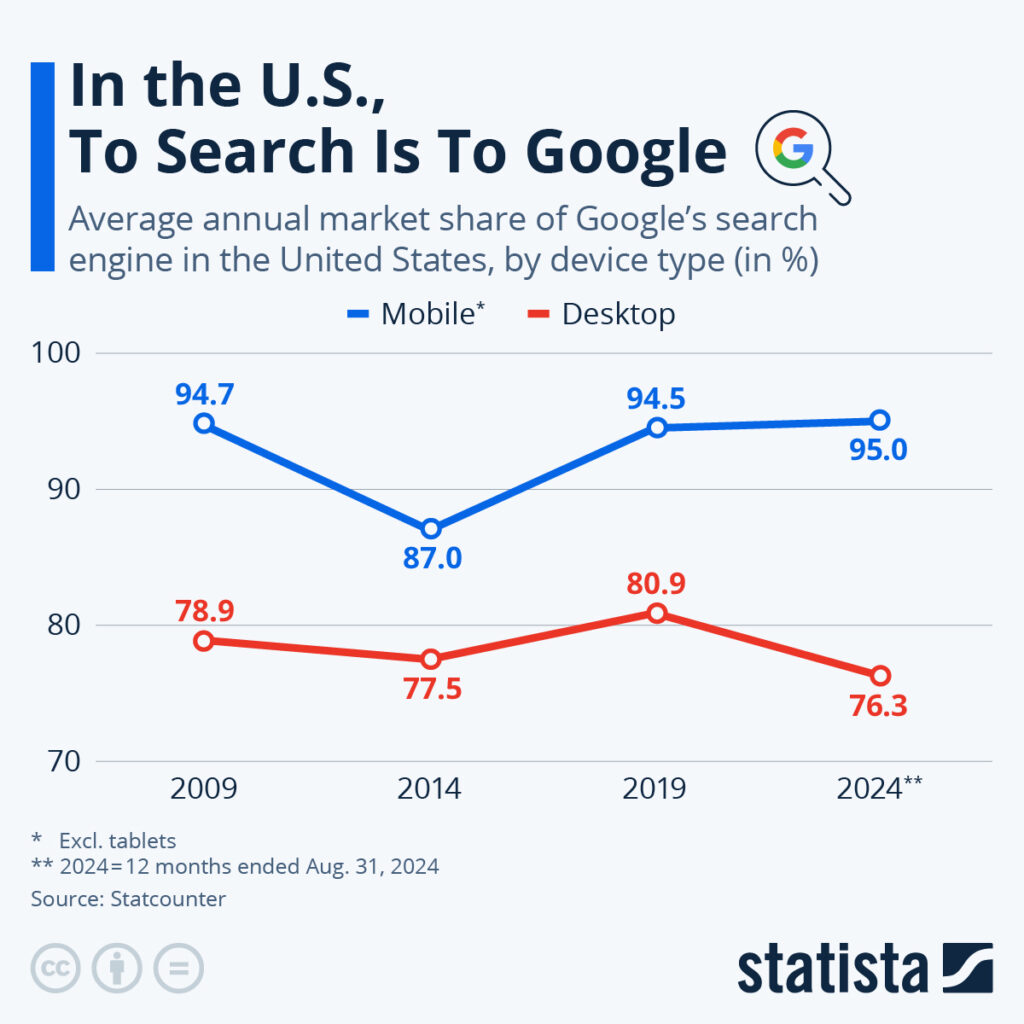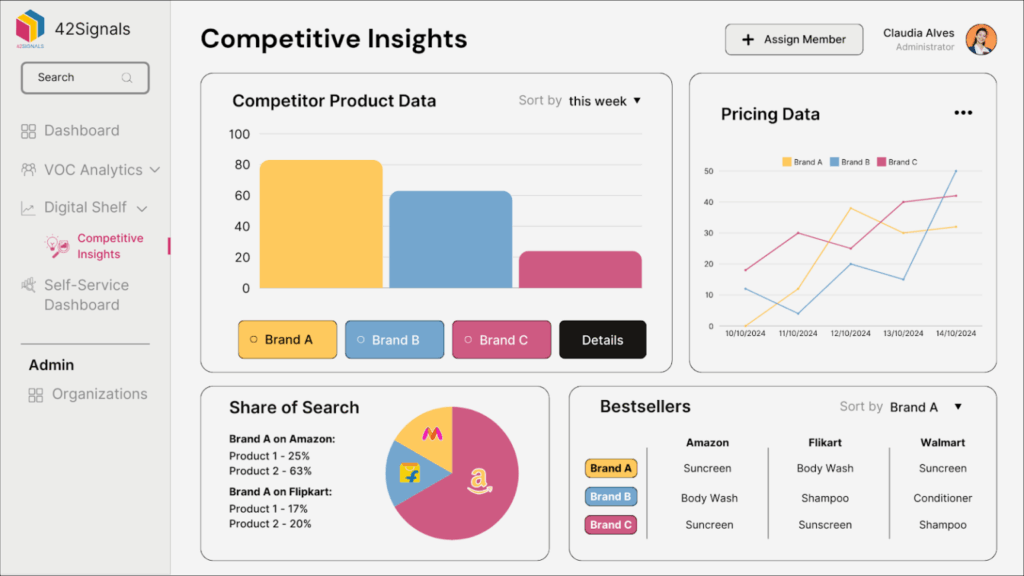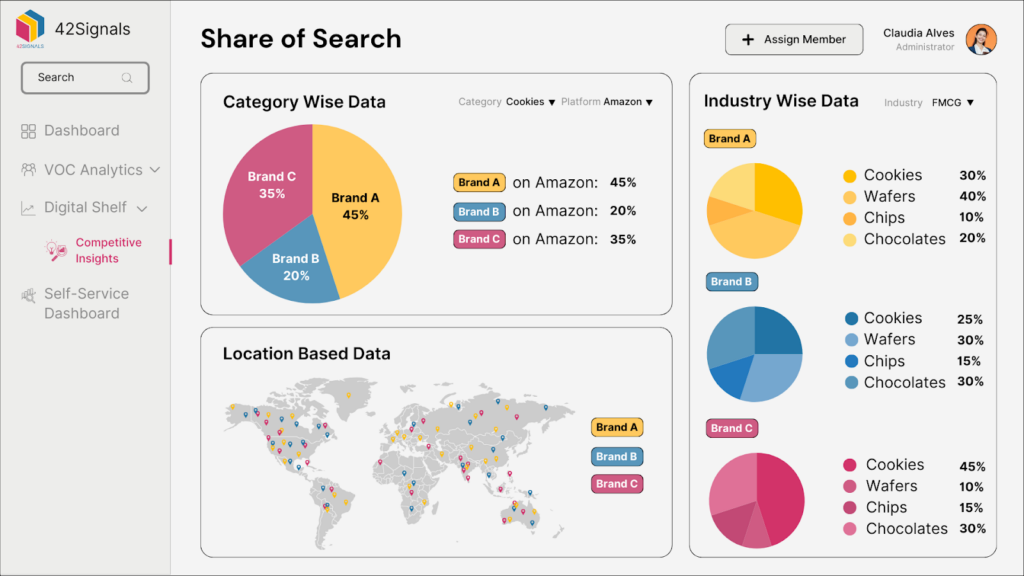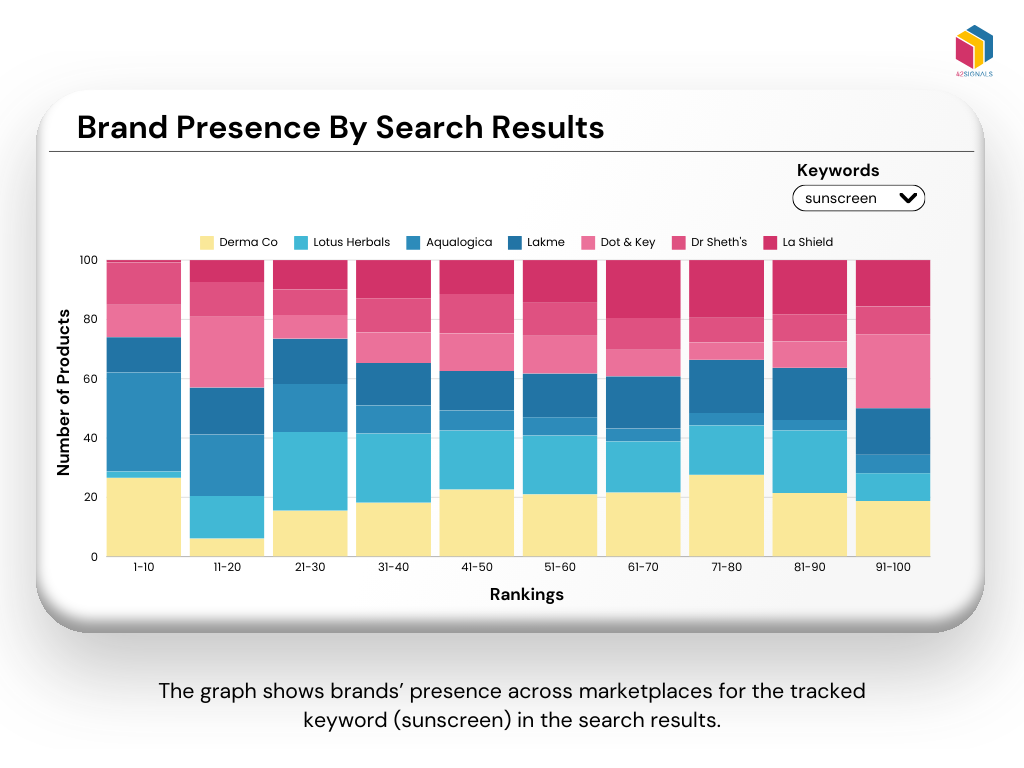Table of Contents
ToggleWhat is a Share of Search Tool?
Share of Search is a powerful metric that represents the percentage of searches a brand captures in comparison to its competitors for specific keywords. This measurement via a share of search tool is crucial for understanding a brand’s visibility and prominence in the digital marketplace.
This is where Share of Search (SoS) emerges as a transformative, yet frequently underestimated, key performance indicator. By assessing how frequently a brand appears in search results relative to its competitors, marketers can gauge the effectiveness of their SEO strategies and overall market presence.

Image Source: Statista
Think of it as a real-time, always-on opinion poll of consumer demand and intent, offering a powerful proxy for future market share.
What Role Do Keywords Play in Share of Search?
Keywords are far more than just SEO metadata or pay-per-click bid terms; they are the literal language of your customer’s intent. They are the questions, needs, desires, and problems typed into a search bar. In the context of Share of Search, they serve as the fundamental unit of measurement and the primary lever for influence.
1. Relevance
The core function of keywords is to create relevance. Every search query is a signal of intent—whether informational (“what is the best SPF”), navigational (“La Roche-Posay official website”), or commercial (“buy minimalist sunscreen 50g”). By meticulously researching and targeting the keywords your audience uses, you ensure your brand is present at the exact moment a purchase decision is being considered.
This alignment transforms your content and product pages from mere advertisements into valuable solutions, directly increasing your relevance and, consequently, your share of those critical search results.
2. Competitor Benchmarking with a Share of Search Tool

Keywords provide the X-ray vision needed to see through your competitors’ strategies. By analyzing the keyword landscape, you can answer pivotal questions:
- Which specific terms are they ranking for organically?
- What paid keywords are they bidding on aggressively?
- Which high-value keywords have they overlooked, presenting a potential opportunity for your brand?
- How does their keyword portfolio shift with new product launches or seasonal trends?
This benchmarking turns a abstract concept of “competition” into a tangible, analyzable dataset. You’re no longer guessing their strategy; you’re reverse-engineering it through their keyword choices.
3. Product Strategy
Effective use of keywords can drive your product strategy that resonates with search intent, thereby increasing your share of search.
A surge in searches for “reef-safe sunscreen” or “mineral sunscreen for sensitive skin” is not just a trend to capitalize on in ads; it’s a clear directive from the market about evolving consumer preferences. A brand that tracks these keyword trends can adapt its product formulation, highlight these features in its listings, and create educational content that addresses these specific concerns.
This proactive approach, driven by search data, ensures your offerings resonate deeply with search intent, capturing a larger share of demand and establishing your brand as a forward-thinking leader.
Keywords are, therefore, the essential bridge. They connect the uncharted territory of user intent to the owned land of your brand’s digital visibility. Without a sophisticated keyword strategy, attempts to increase Share of Search are akin to sailing without a compass.
Why is it Important for Brands to Keep Track of Competitors with a Share of Search Tool?

In the digital arena, your competitors are only a click away from your customers. Ignoring their presence and performance is a strategic blind spot with significant consequences. A dedicated Share of Search tool transforms this competitive intelligence from a sporadic manual task into a systematic, actionable strategy.
1. Competitive Advantage
Understanding your competitors’ Share of Search is not about imitation; it’s about innovation and differentiation. By monitoring their keyword strengths and weaknesses, you can identify gaps in the market. If all major competitors are dominating broad, high-volume terms like “sunscreen,” but neglecting long-tail, high-intent keywords like “oil-free sunscreen for acne-prone skin,” you have identified a blue ocean. You can dominate this niche, capturing highly qualified traffic and converting it at a higher rate, thereby building a defensible competitive moat.
2. Consumer Insights
Competitors’ keyword rankings are a reflection of what the market is responding to. The terms they successfully rank for are validated by consumer clicks and engagement. By analyzing this, you gain indirect but incredibly valuable insights into consumer preferences without commissioning expensive market research. You can see which features are being searched for, which benefits are emphasized, and even how language and terminology evolve within your category. This is real-world, behavior-based data that is unparalleled in its honesty.
3. Performance Measurement
Vanity metrics like website traffic or social media likes can be misleading. Share of Search provides a relative and objective measure of your marketing performance. Are your recent SEO efforts actually helping you steal visibility from Competitor A? Is your new content campaign increasing your share for your core branded terms? By tracking your Share of Search over time and against specific competitors, you can directly correlate marketing activities with changes in market visibility, justifying investments and pivoting quickly from underperforming tactics.
4. Market Adaptation
Keeping an eye on competitors’ keyword strategies helps you adapt to market changes swiftly, ensuring your brand remains relevant and competitive.
A Share of Search tool provides real-time alerts. If a competitor suddenly gains rank for a cluster of important keywords, you can be notified immediately. This allows you to investigate—did they launch a new product? Run a major PR campaign? Change their page metadata?—and adapt your strategy in days, not months, ensuring your brand remains perpetually relevant and competitive.
In essence, tracking competitors through Share of Search is about moving from a reactive to a proactive stance. It’s about anticipating market shifts and seizing opportunities before they become obvious to everyone else.
How Can Brands Keep Track of This?
To effectively monitor and optimize your Share of Search, leveraging advanced tools is essential. Theoretically, one could attempt to track Share of Search manually. This would involve:
- Creating a massive spreadsheet of hundreds of industry-relevant keywords.
- Manually searching for each keyword on each target platform (e.g., Amazon, Google, Flipkart) in different geographies to account for location-based results.
- Recording the position of your products and your competitors’ products for every single search.
- Repeating this process daily or weekly to track movements.
- Attempting to synthesize this overwhelming data into a coherent percentage or insight.
This process is not only mind-numbingly tedious and time-consuming but also fundamentally flawed. It is prone to human error, impossible to scale, and instantly outdated. The sheer volume of data and the speed at which search results change make manual tracking completely impractical for any brand serious about competing online.
To effectively monitor and optimize your Share of Search, leveraging advanced, automated tools is not a luxury; it is an absolute necessity. One such tool designed specifically for this purpose is 42Signals.
Using 42Signals for Share of Search Tracking
42Signals is a cutting-edge digital shelf analytics tool that enables brands to track their Share of Search across various channels and platforms. Here’s how it can help:
1. Multi-Platform Monitoring
A brand’s presence isn’t confined to one channel. 42Signals provides unified insights into your brand’s search performance across all critical e-commerce platforms like Amazon, Flipkart, Walmart, and more, all from a single dashboard. This holistic view is crucial, as consumer behavior and competitive dynamics can vary significantly from platform to platform.
2. Competitor Analysis
The tool allows you to define and track a specific set of competitors for each product category. It goes beyond just showing who ranks #1. It reveals the entire landscape: which competitors are consistently appearing on the first page, which are gaining traction for which keywords, and how their Share of Search fluctuates over time. This allows for incredibly informed strategic decisions regarding product positioning, pricing, and promotional strategies.
3. Data-Driven Decisions
42Signals delivers real-time, accurate data on keyword rankings and search visibility. This empowers teams to move away from gut-feel decisions. For example, the data can inform:
Inventory & Forecasting: A rising Share of Search is a leading indicator of rising demand, allowing for better inventory planning.
SEO Strategy: Double down on keywords where you are on the cusp of page one.
PPC Strategy: Identify high-opportunity keywords where competitors have organic dominance, suggesting a potential paid opportunity to steal visibility.
Content Strategy: Create content tailored to keywords with high search volume but low competition.
4. Actionable Insights
The tool offers actionable ecommerce insights and recommendations on how to improve your share of search, optimize your keyword strategy, and ultimately increase your market presence.
Let’s say you have a skincare brand whose highest-selling product is sunscreen. While it has been the bestseller for long, in the past couple of months you have seen your sales drop while your competitor’s sales are on the rise!
Putting It All Together: The Sunscreen Example Revisited
Let’s say you have a skincare brand whose highest-selling product is sunscreen. While it has been the bestseller for long, in the past couple of months you have seen your sales drop while your competitor’s sales are on the rise!
One of the reasons for this could be because each time a customer looks for sunscreen on an e-commerce platform such as Amazon, the products that show up at the top are those of your competitors instead of yours.
Without 42Signals: You notice the sales dip. You might guess it’s due to competition but have no concrete data. You might manually search for “sunscreen” and see a competitor’s ad. You then decide to increase your ad spend, a costly and reactive move that doesn’t address the root cause—your weak organic visibility.
With 42Signals: You receive an alert that your Share of Search for the core term “sunscreen” has dropped by 40% in three weeks. The tool identifies that two key competitors have overtaken you. Drilling down, you discover they have both begun ranking for new emerging terms like “blue light protection sunscreen” and “sunscreen with niacinamide.” You also see your product listing is missing these keywords and has a weaker conversion rate than your competitors’.
Your Action: You don’t just blindly spend more on ads. You:
- Optimize your product listing to include these high-value, emerging keywords.
- Create a new blog post and video content about the benefits of niacinamide in sun protection, building topical authority.
- Brief your product development team on this trend for future formulations.
- Launch a targeted PPC campaign on these specific terms to capture immediate intent while you rebuild your organic rank.
This is a strategic, data-driven, and multi-faceted response that addresses the immediate problem and builds long-term resilience.

With 42Signals, you can stay ahead of the competition by continuously monitoring and refining your keyword strategy based on real-time data.
Conclusion on Share of Search Tool
Understanding and optimizing your Share of Search is crucial for maintaining and enhancing your brand’s visibility in a competitive digital landscape. Keywords play a pivotal role in this process, acting as the gateway to capturing your audience’s attention and outperforming your competitors.
By keeping track of your competitors’ keyword strategies and leveraging advanced tools like 42Signals, you can stay ahead of the curve and dominate your share of search.
Ready to take control of your Share of Search? Schedule a Demo today and elevate your brand’s digital presence!
Frequently Asked Questions
What is an example of a share of search?
An example of Share of Search would be comparing the number of Google searches for “Nike” against other athletic shoe brands like “Adidas,” “Puma,” and “Reebok” over a specific period.
Let’s say:
- “Nike” had 50,000 searches
- “Adidas” had 30,000
- “Puma” had 15,000
- “Reebok” had 5,000
The total searches for this category = 100,000.
Nike’s Share of Search = (50,000 / 100,000) × 100 = 50%
This means half of all brand-related searches in the category were for Nike—indicating stronger interest or awareness in the digital space.
What is the difference between SoS and SOV?
Though Share of Search (SoS) and Share of Voice (SOV) are both brand visibility metrics, they focus on different things:
- SoS is based on how frequently a brand is searched for online relative to competitors. It reflects organic consumer interest, often before a purchase decision.
- SOV typically measures a brand’s presence in paid media—how much advertising share it holds compared to others. It can apply to digital ads, TV, radio, or social media campaigns.
In short:
- SOV = paid or earned exposure
- SoS = consumer-driven interest (search intent)
SoS is increasingly seen as a leading indicator of brand health, especially in digital markets.
How do you calculate the share of search?
To calculate Share of Search:
Step 1: Identify the main brands in your category.
Step 2: Use tools like Google Trends, Ahrefs, or SEMrush to get monthly search volumes for each brand.
Step 3: Add up the total search volume for all brands in the category.
Step 4: Apply the formula:
Share of Search (%) = (Your Brand’s Search Volume ÷ Total Search Volume) × 100
For example, if your brand has 20,000 searches out of a total of 100,000, your Share of Search is 20%.
What is search share?
Search Share, often used interchangeably with Share of Search, refers to the percentage of total search traffic that a brand or product receives within a specific industry or keyword category. It helps marketers understand how visible or top-of-mind a brand is when consumers search for related topics online.
Unlike website traffic or ad impressions, search share reflects direct consumer intent and can serve as a proxy for market interest, awareness, or brand momentum—especially when tracked over time.





